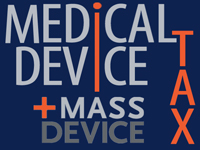
Medical device execs expect the impending 2.3% medical device levy to assail their businesses on multiple fronts once the measure takes effect in January 2013, according to a new survey.
More than 60% of the 190 med-tech money-managers polled said they’re anticipating negative effects for their bottom lines. Nearly as many said they expect the tax to increase compliance costs.
The levy on revenues has been a bone of contention for device makers and industry advocates since it was first floated in 2009 as part of President Barack Obama’s landmark health care reform law. The med-tech sector has been lobbying hard for repeal since before the measure was enshrined in the Affordable Care Act the next year.
"Although many may still be hoping for legislative relief, it would be prudent to assume that a first deposit of medical device excise tax will be due by January 29, 2013, and the first quarterly federal excise tax return will be due by April 30, 2013," KPMG partner Adam Uttley said in prepared remarks.
The poll reinforces the industry’s mantra that the tax will push device makers to lay off workers, raise prices or slash R&D budgets to deal with the tax, which is expected to raise upwards of $30 billion over the next 10 years.
The poll’s results showed that 40% of companies are already looking for ways to offset the tax, including raising prices and lowering headcounts.
More than half of those surveyed were also worried that the tax may present challenges in terms of compliance, citing confusion about which products fall under the tax and how to implement systems to tally charges.
"Manufacturers and importers of medical devices have a great deal of work to do in order to prepare to begin reporting the tax, which is effective for sales on and after the January 1, 2013, effective date and applies to their sales of taxable medical devices in the United States," KPMG pharmaceutical and medical device practice national tax leader Frank Mattei said in prepared remarks. "Companies will need to become familiar with the excise tax rules, identify their affected entities and products, and develop the appropriate compliance processes. A ‘gap’ analysis should be conducted as soon as possible to identify areas that need to be addressed."

